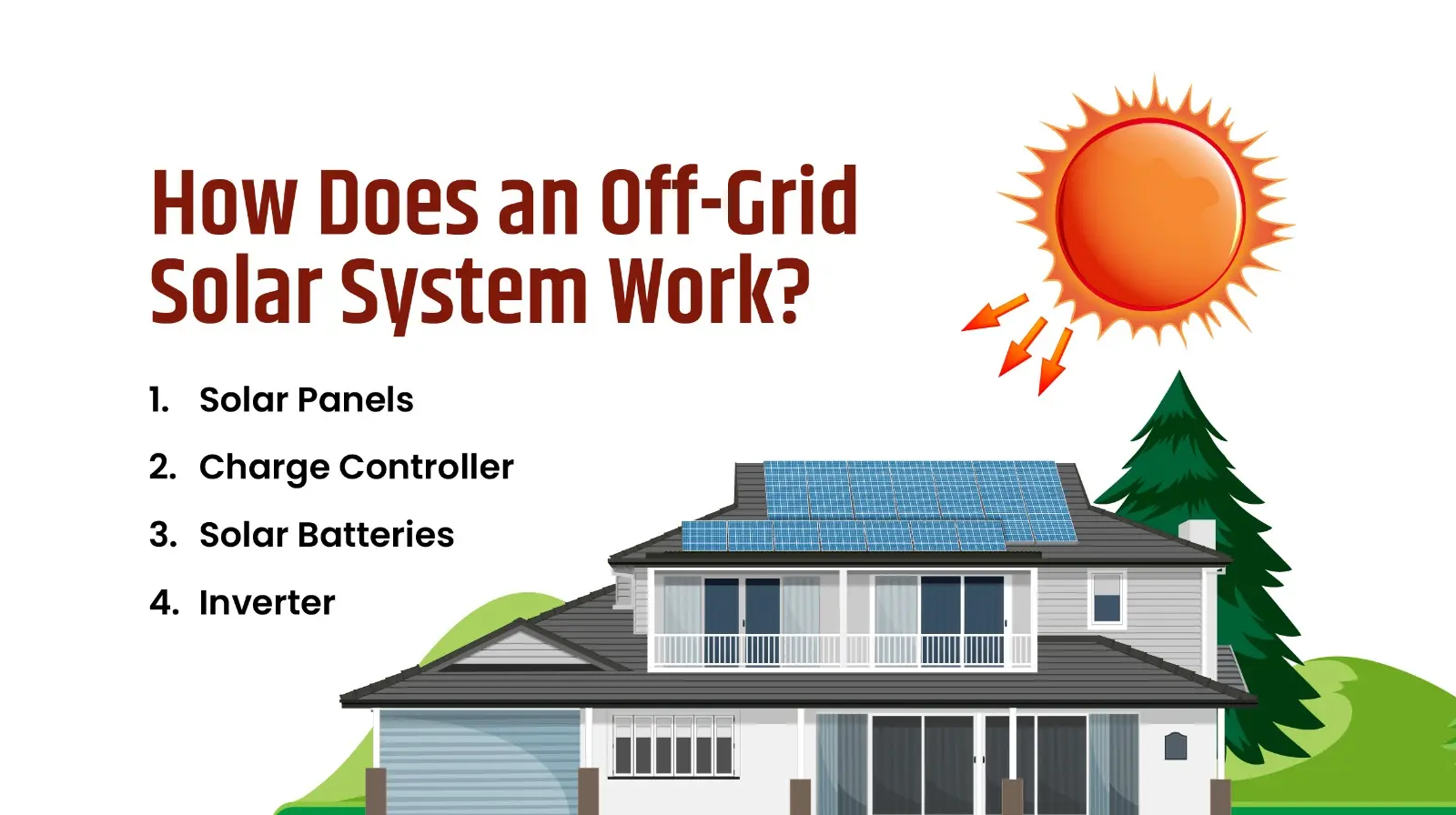What Is an Off-Grid Solar System?
Sunlight by day becomes the electricity that keeps the night bright. No need to rely on outside energy sources, no high electricity costs, and no frequent power outages. An off-grid solar power system's magic lies in that. An off-grid solar system is one that doesn't require a connection to the local electricity grid. It works independently of the grid, hence the name.
In this system, solar panels harness solar energy. Either households or appliances use the generated energy instantly or it goes to solar batteries for later use. The best part about off-grid solar power systems is the solar batteries they come with! These make the systems useful even when the sun is not shining.
Are you curious about the amazing off-grid solar system and want to understand it better? Read on.
How Does an Off-Grid Solar System Work?

You may often wonder how an off-grid solar system works so efficiently. The magic happens with the help of the key parts of the off-grid solar power systems. Let's learn how a solar power system makes the appliances run.
1. Solar Panels
Solar panels or PV panels are the heart of an off-grid solar system because of their function. The amazing job of converting the warm sunlight into electricity is done by these panels by the means of the photovoltaic effect. The electricity that these solar panels produce is direct current electricity.
Learn more in detail about the solar panel components and how photovoltaic panels create power.
2. Charge Controller
Like all things in life need balance, similarly, an off-grid solar system needs it too. A charge controller makes sure of it. It controls the amount of solar energy that reaches the batteries. Incorrect charging can cause damage and low performance from your batteries.
3. Solar Batteries
Off-grid solar power systems are only able to produce electricity when the sun is shining, as you are already aware. The panels won't be able to receive sunlight to produce electricity after the sun goes down. Here's where the concept of solar energy storage enters the picture.
You can, in this way, power your house and appliances without relying on the main power grid and also during power cuts or bad weather.
4. Inverter
The appliances in your home require alternating current (AC) to function. And because the off-grid solar power systems generate direct current (DC), your system won't work without an off-grid solar inverter. The inverter converts the DC electricity into AC electricity.
Let's go through the process again: sunlight → solar panels → charge controller → batteries → inverter → appliances. Simple, right?
Benefits of Off-Grid Solar Power Systems

Are you thinking that saving electricity bills is the only thing an off-grid solar system does well? Well, you're in for a surprise. Let's go through all the benefits of off-grid solar power systems.
● Complete Energy Independence
Relying on the local electricity grid can at times prove to be tiresome. Who wants to face unexpected power cuts and unreliability? No one! With an off-grid solar system, you’ll be free of such worries as you’ll be able to generate your own electricity. For people living in rural areas, this energy independence is a boon!
● Reduced Electricity Bills
Your money will be saved with the installation of an off-grid solar system. The initial cost will be a bit high, but after that get ready to save your pocket. Off-grid solar power systems generate electricity using the sun as the main source. And the solar power is free of cost which makes the solar system cost-effective. The continuous use of off-grid solar systems will reduce electricity bills to a great extent.
● Sustainable and Eco-Friendly
When it comes to development, the environment faces all the challenges. An off-grid solar system will lift your worries about the environment and the future. The minimal negative environmental impact is what makes these systems so popular.
You already know that solar energy is a clean and green source and when people use solar power systems to harness the same energy, it benefits a lot. First, there's a reduction in the reliance on fossil fuels, and second, these off-grid solar power systems contribute to a greener and sustainable future.
● Ideal for Remote Locations
There are areas where proper grid connectivity hasn't been reached yet. And laying down the whole electricity grid may not be a feasible option, such places can benefit from the off-grid solar power systems. The power will be supplied constantly with the help of solar energy. This method is not only eco-friendly but also wallet friendly!
● Low Maintenance, High Durability
An off-grid solar system requires very minimal care. They do function pretty well but you’ll be surprised to know how low-maintenance they actually are. Most solar panels are designed to last up to 25 years, and batteries can last up to 10 years. With the necessary services, your off-grid solar power systems will keep running for years and prove to be a fruitful investment.
● Boost Property Value
There are so many benefits of off-grid solar systems for homes. Whether you live in it or decide to sell it. Potential buyers are drawn to properties with solar panels because they are considered valuable and appealing. Everybody desires a house with small carbon emissions and low energy expenses. Therefore, installing an off-grid solar system can significantly increase the value of your home!
Installation Process of an Off-Grid Solar System
The installation process can be a bit complex when you compare it to setting up traditional home appliances. Let's break it down for you.
Step 1: Site and Energy Assessment
The first step before installing an off-grid solar system is always to analyse your own energy needs. And then the power your home consumes. You have to first assess your energy consumption in order to determine the amount of power you need to generate.
Step 2: Choosing the Right Components
Each component makes up a whole solar power system. And for the good-quality and efficient one, you’d need to select the right solar panels, batteries, inverters, and charge controllers. High-quality components for high energy production!
Step 3: Installing Solar Panels and Batteries
Now that you've got everything you require, begin by mounting your solar panels. There are different solar mounting structures to choose from. These panels are usually installed where there's maximum sun exposure, generally on the roofs or nearby fields. The solar batteries are also installed in a safe, dry place.
Read more about the Benefits of Rooftop Off-grid solar systems.
Step 4: Connecting the System
Wiring the system up is an important step in the installation process. How would your solar panels function without it? So, the process includes connecting solar panels to the charge controller, which manages the batteries. The installation of an off-grid solar inverter is what helps the most. These inverters will convert DC electricity into AC electricity.
Step 5: System Testing and Monitoring
It doesn't just end with setting up the whole off-grid solar system. You need to see if everything is set and working properly. Smooth running of solar power systems is what you should aim for. You can also monitor your energy production and consumption for better efficiency and use.
Cost of Installing an Off-Grid Solar System
We understand that the concept of installing off-grid solar power systems might look a little confusing and expensive in the beginning. But you must believe us when we tell you it'll be worth every dime and the effort you invest.
While understanding the installation costs, you'll discover that the cost is determined by a lot of factors. They include manufacturers, solar companies, location, and energy consumption. The solar systems’ capacity ranges from 0.5kW to 10kW. An average cost would be around ₹80,000 to ₹600,000 or more for large systems.
For a 1 kW off-grid solar system, the cost varies based on battery configuration:
● Single Battery (12V): Approximately ₹80,000
● Double Battery (24V): Approximately ₹100,000
Government Subsidies for an Off-Grid Solar System in India
The Indian Government has taken commendable steps towards sustainability. We can all agree that solar panel subsidies are the best encouraging factor in increasing solar energy use. Not only this, but at a lower investment, you are becoming part of an environment-friendly cause!
These subsidies offered by the Government are extremely beneficial for remote and rural areas. Such places are still not connected to a proper grid system, making life difficult for people living there. A larger solar network will allow for a more reliable power supply and a better quality of life. Also, low-income households need to spend a minimum amount to install an off-grid solar system if they opt for Government subsidies.
The Indian Government has many such offers for both residential and commercial solar systems. Make sure to continue reading to know more!
PM Surya Ghar: Muft Bijli Yojana
This scheme provides for a subsidy of up to 60% for systems up to 2kW. For additional systems, it offers a 40% subsidy.
● ₹30,000 subsidy for a 1 kW system
● ₹30,000 per kW (up to 2 kW systems)
● ₹78,000 for 3 kW systems or higher.
The subsidy for the Resident Welfare Association (RWA) and Group Housing Society (GHS) is ₹18,000 for common facilities.
Grid-Connected Rooftop Solar Programme
The Grid Connected Rooftop Solar Programme, led by the Ministry of New and Renewable Energy (MNRE), is helping homeowners across India. The goal here is to install 40,000 MW of solar power by 2026. Plus, this scheme offers a generous Central Financial Assistance (CFA) that covers 40% of the cost for systems up to 3 kW and 20% for systems between 3 kW and 10 kW.
Conclusion
Off-grid solar power systems are helping the world move forward into a brighter future. An off-grid solar system not only helps with our energy needs but also looks after the environment. KLK Ventures is always there to help you with solar solutions. Contact us if you're looking for more information or any sort of guidance.
